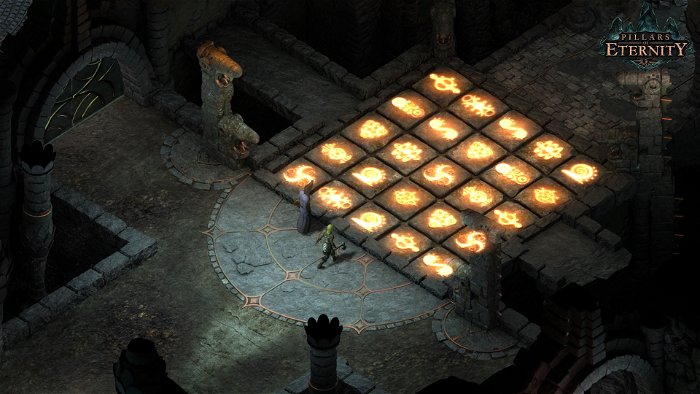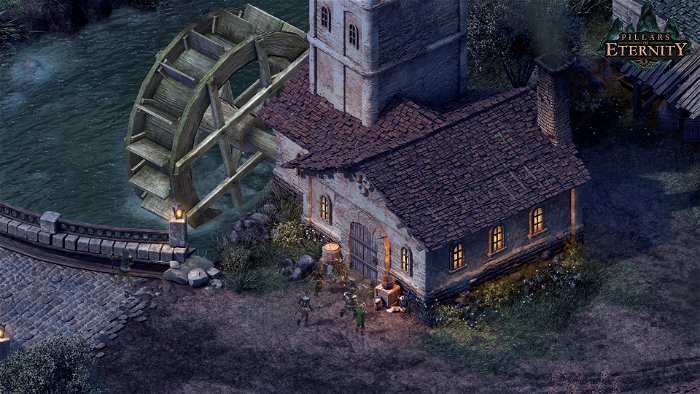
I’ve spent about 10 hours playing Obsidian Entertainment’s Pillars of Eternity and I still can’t figure out what’s going on. This isn’t to say that I have no idea what I’m doing—the basic loop of exploring towns and dungeons, fighting monsters, and chatting with different characters is straightforward enough—just that there are layers to the game that haven’t surfaced yet. I’m still unable to keep track of all the different gods and nations referenced in the story and haven’t been able to grasp the finer points of the myriad of combat statistics. There’s a constant sense of disorientation involved with playing the game that seems to have more to do with my own lack of experience with Pillars’ genre predecessors—Baldur’s Gate, Planescape: Torment, etc.—than anything else.
In a lot of cases, confusion during a title’s opening hours brings a welcome depth. A game like The Witcher 3: Wild Hunt introduces enough narrative and mechanical mystery in its first several hours that it takes a while before the player feels comfortable with its fictional history and geography or the intricacies of its various gameplay systems. But, when this understanding does arise, it comes as the natural result of simply playing the game, paying attention to tutorials, exploring maps, and taking the time to chat with newly introduced characters. Wild Hunt understands that its players—even those who have played previous Witcher titles—need to be gradually introduced to its world and mechanics. That’s why it reveals the complexities of its plot gradually. The player needs time to acclimate to its story and mechanics.
Pillars of Eternity takes the opposite approach. Without much in the way of guidance, it dumps the player into a plot full of invented nations, species, and nations and asks them to figure out seemingly infinite character and combat statistics. There are glossaries, sure, but they have a way of running together when so much information is presented all at once. As soon as the player gets a grasp on one aspect of the game, s/he remembers entire systems or fictional terminology that still seem nonsensical. But, this isn’t a common complaint. Most players, having come to Pillars with experience in the classic games it’s inspired by, are able to adapt to its systems and narrative style. For the rest of us, the type of bewilderment that playing Pillars of Eternity involves feels like stumbling into a second year university classroom without having completed the proper pre-requisite course.
The rebirth of classic videogame genres enabled by Kickstarter crowdfunding is a great proposition for fans hungry for new experiences in the vein of their favourite older games. This model has made it possible for players to enjoy new point-and-click adventures and tactical combat games, and for computer role-playing (CRPG) titles like Pillars of Eternity to exist. But, in all the excitement to revive these kind of games, players without prior experience in their genres—players who may love what they find if they’re properly introduced to outmoded gameplay conventions—are left out in the cold. They haven’t internalized the expected quirks of older titles. Without a proper introduction to systems and storytelling methods that no longer appear in games—or that are just plain confusing for their density—it can be hard to see why developers and fans are interested in their return.
It’s difficult to think of a real solution to this problem. Players who want revivals of dormant or niche genres are finally able to enjoy them when developers like Double Fine Productions or Obsidian Entertainment use Kickstarter as a funding method. It’s fantastic that crowdfunding makes it possible for projects to exist that wouldn’t be bankrolled by a mainstream publisher, but, it also seems like the developers working on these throwback titles could benefit from remembering that it isn’t only nostalgic players who are interested in their work. We’ve seen how the concessions of middle-ground approaches typically work in videogames—the design simplification that results is the reason for these Kickstarters to exist in the first place—yet features like extra tutorials would do little to take away from the rest of the experience. Whatever the shape, it’s important for developers to consider making some affordances for genre newcomers; otherwise, an entirely new audience is left unable to discover what made so many players nostalgic for these revivals in the first place.






